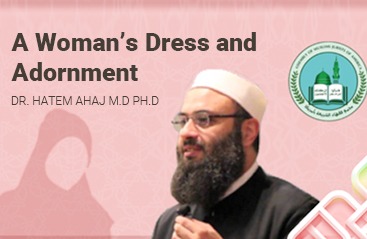
10th Annual AMJA Conference – Kuwait
Contemporary Issues Related to Women Outside the Lands of Islam
A Woman’s Dress and Adornment
Dr. Hatem al-Haj
Member of the Resident Fatwa Committee of AMJA
In the name of Allah, the Most Merciful, the Grantor of Mercy. All praise is due to Allah, and may salutations and peace be upon the seal of His Messengers and His most cherished slave, and upon his family and companions.
The issue of a woman’s dress code and adornment has been the center of much controversy, where debates and even accusations frequently arise. The duty here is to handle this subject with sincerity and objectivity, while remaining keen to uphold the values our Sharia lays down for a Muslim society, such as dignity, chastity, and modesty. At the same time, we must avoid violating the Sharia itself via an overly strict reading of the Qur’an and Sunnah, or via advocating excessive precautionary measures that would distance us from the ideal society that existed in the city of the Prophet (saws) during his life.
Beauty and Adornment in Islam
Beauty, beautification, adornment, and cleanliness are part of the fitrah (innate disposition) which Allah disposed those of sound nature upon, and no religion out there has encouraged purity and beauty as Islam did. For instance, Allah (st) says, “O Children of Adam, take your adornment at every masjid,” [al-A‘râf: 31] and says elsewhere regarding cattle, “And for you in them is [the enjoyment of] beauty when you bring them in [for the evening] and when you send them out [to pasture].” [an-Nahl: 6] Notice how He did not only mention the other benefits it provides, but included His favor upon His slaves in terms of the beauty He endowed therein.
Likewise, the Prophet (saws) said, “Purification is half of faith,” and “Indeed, Allah is beautiful and loves beauty,” and “Whoever has hair, let him honor it.”
Women and Adornment
Beauty and adornment can be considered an inborn need when it comes to women, as the Most High says, “So is one brought up in ornaments while being during conflict indistinct [attributed to Allah]?” [az-Zukhruf: 18] Likewise, we find the Prophet (saws) deeming gold and silk forbidden for men, but permitting them for women, and find him especially stressing the importance of a woman’s beautification for her husband. However, some aspects of a woman’s adornment are only lawful for her husband, some are only lawful for her mahram relatives and fellow women, some are lawful in every situation, and some are disliked or unlawful in any situation. The issue of a woman’s adornment is certainly great, due to what negligence towards it can trigger of corruption, and for that reason the Prophet (saws) went as far as stipulating from those pledging allegiance to renounce tabarruj (immodest display of adornment) as part of their pledge!
General Guidelines for Clothing and Adornment
In Islam, the hijab (veil) is not merely a garment, but rather a complete lifestyle in terms of how she deals with the male gender. A Muslim woman distances herself from suspicion, does not speak in a tone that makes the diseased at heart hopeful, does not sway the hearts of men by swaying in her stride, and is keen to not mix with them except for a need. But when hijab became culture, and when the point behind it disappeared from the minds of our daughters, and when we lost sight of it being a means to achieving chastity and respect, its effect was lost. It is mindboggling to see a young woman with hijab that flirts with men or softens her voice when Allah (st) says, “If you fear Allah, then do not be soft in speech [to men], lest he in whose heart is disease should covet, but speak with appropriate speech.” [al-Ahzab: 32] It is baffling to find her covering her head while seeking to uncover her legs, or arms, or more, or to find her crowding with men in tight places where their bodies collide.
The following are some general guidelines for clothing and adornment:
- Taking precautions to ensure chastity and honor is the default. For that reason, the Prophet (saws) commanded Sawadah (rah) to observe hijab in front of a young lad merely because someone argued the possibility of him not actually being her brother.
- Avoiding extravagance. The Prophet (saws) said, “Eat, drink, dress, and donate – without being wasteful or prideful.” Where does the Muslim woman who spends thousands on her beautification stand from this prohibition?
- Avoiding the imitation of men. Abu Hurayrah (ra) said, “The Messenger of Allah (saws) cursed the man who wears the clothing of women, and the woman who wears the clothing of men.”Customs are what determine what is particular to each gender, but in light of what is reasonable for each. If the sound nature of an entire people is perverted, that would still not permit a woman to wear the suit of a man, or a man to wear the headscarf of a woman.
- Avoiding the imitation of disbelieving and irreligious women in that which is symbolic of their disbelief or irreligiousity the Messenger of Allah (saws) said, “Whoever imitates a people is of them.”It should bring anguish to see the Muslim youth – men and women – panting after every call in the east and west, declaring by it their inferiority and the dissolvement of their identity. Hastening to change wardrobes whenever the global fashion lords prompt that is not just foolish, but also falls under the unlawful imitation and despised extravagance.
Clothing
I – Guidelines for Clothing
- It should not be tight and descriptive, nor thin and revealing. Amidst describing two residents of the Hellfire, the Messenger of Allah (saws) said, “And women that are clothed [but in reality] naked, who sway and tempt [others]; their heads are like tilted humps of camels. They will not enter Paradise, nor detect its fragrance, although its fragrance can be detected from such and such a distance.” Clothed but naked refers to wearing attire that does not offer concealment, such as wearing thin garbs that reveal her skin color, or tight garbs that delineate the shape of her hips, rear, arms, and the like.
- It should not be an adornment itself, or a garb of prominence. The Prophet (saws) said, “Whoever wears a garment of prominence in this world will be dressed by Allah in a garment of humiliation on the Day of Resurrection, and then it will engulf in flames.”Clothing which draws the attention of men towards it is clearly an act of undermining the very aim that Allah seeks in enjoining hijab.
- As for the ‘awrah, or the degree which must be covered, this is a long and well-known debate. The majority position is that a woman’s entire body is ‘awrah except for the face and hands, and there is no place here for discussing these views in detail.
II – Styles of Clothing
The stronger position is that the style of hijab is left for the woman, given that she abides by the aforementioned guidelines. According to the correct position, which is the view of the majority, she is not obligated to wear the “jilbab” in particular, especially when its very definition is widely debated. As for its explicit mention in Surat al-Ahzâb, that is because of how common it was among those women; may Allah be pleased with them.
Based on that, perhaps a woman can wear wide pants if above them is a long shirt that conceals her body to the knees or lower. But if the pants are tight and the over-garment is short, this cannot be permissible because it defines her body and her most private parts. Ideally, a woman who doesn’t wear the jilbab should choose to wear an over-garment that reaches her knees, with a skirt beneath it.
The khimâr (head covering) is whatever covers the head, and the Qur’an adds that it should cover the chest opening as well.
Adornment
Most of a woman’s adornment should only be displayed in front of her mahram relatives, and certain aspects of it can only appear to her husband, as Allah (st) instructs in Surat an-Noor. As for the exception in the verses of “what ordinarily appears thereof,” most of the narrations from the Companions agreed with the statement of Ibn ‘Abbâs (ra), namely that this refers to the hands and the ‘kohl’ eyeliner. Even the narration from Ibn Mas‘ood (ra) that says it refers to clothing does not necessary contradict that.
The following are some guidelines particular to the issue of adornment:
- It must not involve altering the creation of Allah, for it has been confirmed in multiple hadith(s) that the Prophet (saws) cursed those who alter the creation of Allah, whether by tattooing, plucking the eyebrows, or filing the teeth for beautification.
- Its usage must not result in any harm, for some creams and makeup do in fact damage the skin.
Types of Adornment
- Hair and Nails. It is permissible for a woman to lengthen her hair, for that is the norm, and she can also shorten it on the condition that it does not resemble men, for ‘A’ishah (rah) narrated that the wives of the Prophet (saws) used to trim their hair. As for nails, the Sunnah is to not lengthen them, and Anas (ra) narrated that the Prophet (saws) taught them to not exceed 40 days without cutting their nails.
- Jewelry. Imam Nawawi said, “The Muslims are unanimously agreed on the permissibility of a woman wearing all the various types of gold and silver jewelry, such as necklaces, rings, bracelets, and anklets. There is no disagreement about any of this.”
- Makeup. A woman can beautify her body and hair with these dyes, such as the henna which has been recommended in the authentic Sunnah. A woman dying her hair black is controversial, and the stronger view is this being disliked for the very old woman, just like the case with a very old man.
Applying nail-polish is permissible, for it is analogous to dye, unless the woman is currently praying. In that case, it would be unlawful because it prevents the water from reaching beneath it during wudu’ (ablution) and ghusl (ritual bathing).
Reddening the lips and cheeks is permissible for the married and unmarried, but only in front of her mahram relatives, and while observing the aforementioned condition of not being wasteful.
There is more leniency when it comes to a woman using kohl (eye makeup), khidâb (hand makeup), rings, and other similar adornments, especially for those single and seeking marriage. This is founded by the Prophet (saws) tacitly approving when Subay‘ah (ra) had beautified herself for the suitors once her ‘iddah (waiting period) had ended.
- Perfume. It is strictly prohibited for a woman to perfume herself anywhere that would allow men to detect her fragrance, due to the multiple hadith(s) emphatically condemning that. While many societies overlook such a factor, the wisdom of the Sharia highlights for man these subtleties that provoke lusts and undermine the modesty of civilizations. This prohibition is particular only to cases when foreign men could detect her scent, whether en route or upon arrival to her destination.
And may the peace and salutations of Allah be upon our Prophet, Muhammad.






